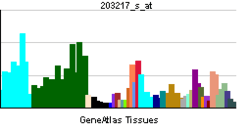ST3GAL5
| View/Edit Human | View/Edit Mouse |
Lactosylceramide alpha-2,3-sialyltransferase is an enzyme that in humans is encoded by the ST3GAL5 gene.[3][4]
Ganglioside GM3 is known to participate in the induction of cell differentiation, modulation of cell proliferation, maintenance of fibroblast morphology, signal transduction, and integrin-mediated cell adhesion. The protein encoded by this gene is a type II membrane protein which catalyzes the formation of GM3 using lactosylceramide as the substrate. The encoded protein is a member of glycosyltransferase family 29 and may be localized to the Golgi apparatus. Mutation in this gene has been associated with Amish infantile epilepsy syndrome. Transcript variants encoding different isoforms have been found for this gene.[4]
Mutations in this gene have also been associated to ‘Salt & Pepper’ syndrome: an autosomal recessive condition characterized by severe intellectual disability, epilepsy, scoliosis, choreoathetosis, dysmorphic facial features and altered dermal pigmentation (doi: 10.1093/hmg/ddt434)
References
- ↑ "Human PubMed Reference:".
- ↑ "Mouse PubMed Reference:".
- ↑ Ishii A, Ohta M, Watanabe Y, Matsuda K, Ishiyama K, Sakoe K, Nakamura M, Inokuchi J, Sanai Y, Saito M (Dec 1998). "Expression cloning and functional characterization of human cDNA for ganglioside GM3 synthase". J Biol Chem. 273 (48): 31652–5. doi:10.1074/jbc.273.48.31652. PMID 9822625.
- 1 2 "Entrez Gene: ST3GAL5 ST3 beta-galactoside alpha-2,3-sialyltransferase 5".
Further reading
- Bonaldo MF, Lennon G, Soares MB (1997). "Normalization and subtraction: two approaches to facilitate gene discovery". Genome Res. 6 (9): 791–806. doi:10.1101/gr.6.9.791. PMID 8889548.
- Fukumoto S, Miyazaki H, Goto G, et al. (1999). "Expression cloning of mouse cDNA of CMP-NeuAc:Lactosylceramide alpha2,3-sialyltransferase, an enzyme that initiates the synthesis of gangliosides". J. Biol. Chem. 274 (14): 9271–6. doi:10.1074/jbc.274.14.9271. PMID 10092602.
- Kapitonov D, Bieberich E, Yu RK (2000). "Combinatorial PCR approach to homology-based cloning: cloning and expression of mouse and human GM3-synthase". Glycoconj. J. 16 (7): 337–50. doi:10.1023/A:1007091926413. PMID 10619706.
- Allende ML, Li J, Darling DS, et al. (2000). "Evidence supporting a late Golgi location for lactosylceramide to ganglioside GM3 conversion". Glycobiology. 10 (10): 1025–32. doi:10.1093/glycob/10.10.1025. PMID 11030748.
- Kim KW, Kim SW, Min KS, et al. (2001). "Genomic structure of human GM3 synthase gene (hST3Gal V) and identification of mRNA isoforms in the 5'-untranslated region". Gene. 273 (2): 163–71. doi:10.1016/S0378-1119(01)00595-9. PMID 11595162.
- Kim SW, Lee SH, Kim KS, et al. (2002). "Isolation and characterization of the promoter region of the human GM3 synthase gene". Biochim. Biophys. Acta. 1578 (1–3): 84–9. doi:10.1016/s0167-4781(02)00505-5. PMID 12393190.
- Strausberg RL, Feingold EA, Grouse LH, et al. (2003). "Generation and initial analysis of more than 15,000 full-length human and mouse cDNA sequences". Proc. Natl. Acad. Sci. U.S.A. 99 (26): 16899–903. doi:10.1073/pnas.242603899. PMC 139241
 . PMID 12477932.
. PMID 12477932. - Zeng G, Gao L, Xia T, et al. (2003). "Characterization of the 5'-flanking fragment of the human GM3-synthase gene". Biochim. Biophys. Acta. 1625 (1): 30–5. doi:10.1016/s0167-4781(02)00573-0. PMID 12527423.
- Clark HF, Gurney AL, Abaya E, et al. (2003). "The secreted protein discovery initiative (SPDI), a large-scale effort to identify novel human secreted and transmembrane proteins: a bioinformatics assessment". Genome Res. 13 (10): 2265–70. doi:10.1101/gr.1293003. PMC 403697
 . PMID 12975309.
. PMID 12975309. - Ota T, Suzuki Y, Nishikawa T, et al. (2004). "Complete sequencing and characterization of 21,243 full-length human cDNAs". Nat. Genet. 36 (1): 40–5. doi:10.1038/ng1285. PMID 14702039.
- Chung TW, Choi HJ, Lee YC, Kim CH (2005). "Molecular mechanism for transcriptional activation of ganglioside GM3 synthase and its function in differentiation of HL-60 cells". Glycobiology. 15 (3): 233–44. doi:10.1093/glycob/cwh156. PMID 15385432.
- Simpson MA, Cross H, Proukakis C, et al. (2004). "Infantile-onset symptomatic epilepsy syndrome caused by a homozygous loss-of-function mutation of GM3 synthase". Nat. Genet. 36 (11): 1225–9. doi:10.1038/ng1460. PMID 15502825.
- Hillier LW, Graves TA, Fulton RS, et al. (2005). "Generation and annotation of the DNA sequences of human chromosomes 2 and 4". Nature. 434 (7034): 724–31. doi:10.1038/nature03466. PMID 15815621.
- Berselli P, Zava S, Sottocornola E, et al. (2006). "Human GM3 synthase: a new mRNA variant encodes an NH2-terminal extended form of the protein". Biochim. Biophys. Acta. 1759 (7): 348–58. doi:10.1016/j.bbaexp.2006.07.001. PMID 16934889.
- Szabo R, Skropeta D, et al. (2016). "Advancement of Sialyltransferase Inhibitors: Therapeutic Challenges and Opportunities.". Med. Res. Rev. 36: ahead of print. doi:10.1002/med.21407.
